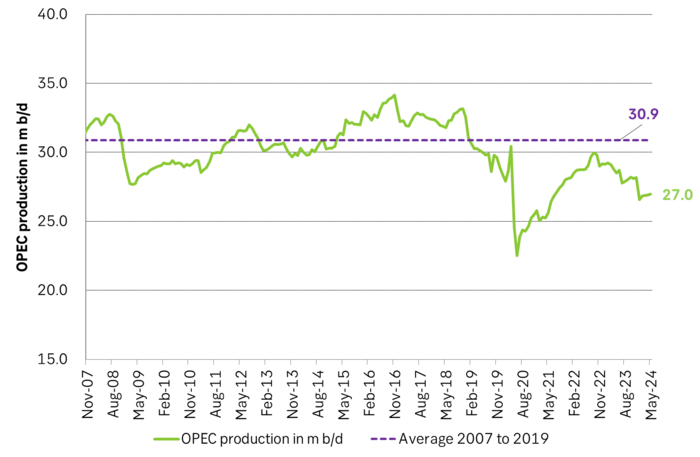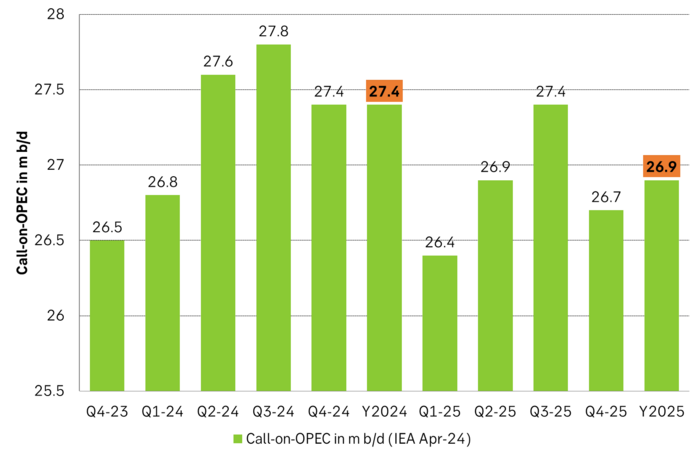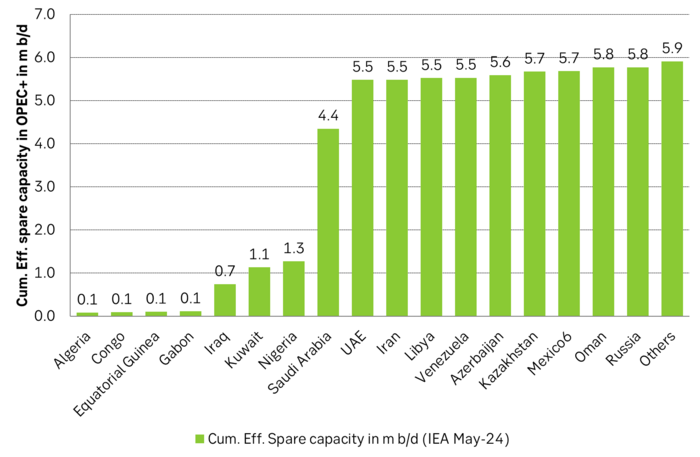Analys
You borrowed our market share – Now we want it back

From ”price over volume” to ”we want our market share back”. OPEC+ changed its wording big time last Sunday as it essentially shifted its strategy from ”price over volume” to instead ”price yes, but also volume”. OPEC+ has been regulating the supply oil oil since May 2020 when oil demand collapsed due to Covid-19. Since then the organisation has continuously been willing to adjust supply to whatever needed to balance the market. Oil market participants thus didn’t need to worry too much about changes in the outlook for global oil demand or non-OPEC+ supply growth as the oil cartel would adjust to balance the market whatever happened. That period has now come to an end. The oil price will now become much more sensitive to macro data related to economic growth and oil demand growth as well as changes in projections in non-OPEC+ production growth.

Little finesse when Saudi Arabia shifted from ”price” to ”volume” in 2014. Back in 2014 when Saudi Arabia decided that enough was enough in terms of losses in market share to booming US shale oil production it shifted tactics from ”price over volume” to ”market share” without much fines. Saudi Arabia then, without saying much, started to drop its Official Selling Prices sharply into the autumn of 2014. Finally in December 2014 it became official that OPEC would no longer shed market share to non-OPEC (essentially US shale) to defend the oil price.
This time however the shift in strategy is done with much more finesse and in a much more clever way. To start with OPEC+ is doing nothing what so ever in Q3-24. No change in production. As demand will seasonally rise a bit in Q3, this should ensure a fairly balanced market with no rise in inventories (maybe even a draw). At least according to estimated need for oil from OPEC+ (paper balances). The communicated plan is then to gradually add around 2 m b/d to the market from Q4-24 to Q3-25 with an increase of 750 k b/d already by January 2025. But the finesse is that the cartel is holding an open door to modify that plan by saying that ”if market circumstances do not allow it” they may not place the 2 m b/d of voluntary cuts back into the market from Q4-24 to Q3-25 anyhow. Anyhow they are making it clear that these volumes will eventually return to the market. And that is something which all non-OPEC+ producers will discuss at boardroom levels going forward.
IEA’s May report projects a decline in call-on-OPEC 2025 of 0.5 m b/d. Not acceptable for OPEC. The IEA, in its May report, is projecting that global demand will rise by 1.1 m b/d while non-OPEC supply will rise by 1.6 m b/d. The result is that OPEC will loose a market share of 0.5 m b/d in 2025 and thus have to cut the same to maintain market balance and prices. OPEC(+) is now saying that that is not a feasible path. They don’t want to cut yet more. Enough is enough.
No one believes that there is room for an additional 2 m b/d without crashing the price. No one believes that there is room in the global oil market for an additional 2 m b/d (the voluntary cuts) from OPEC+ from Q4-24 to Q3-25. At least not without crashing oil prices. The cartel probably doesn’t believe that either. And as a result it has left a backdoor open to modify their plans as they go by saying that they may modify these plans of added supply if market conditions do not allow the return of these volumes to the market.
The message is a warning shot to non-OPEC+ producers to scale back or face the consequences. The latest message from the cartel is a warning shot to non-OPEC+ producers. The market share that non-OPEC+ producers have grabbed since year 2020 is not for them to keep. The oil cartel want these volumes back. Preferably as fast as possible but with some levy with respect to time.
The cartel may hope to influence demand and non-OPEC+ supply for 2025. With its latest communication and actions the cartel may be hoping to modify the outcome for 2025 where the IEA is projecting that call-on-OPEC will decline by 0.5 m b/d. A little bit softer prices now, but no collapse, could help to ease inflation further, reduce interest rates faster, speed up global economic growth and thus potentially lift projected oil demand growth for 2025.
The messaging from the cartel will most likely also be widely discussed in non-OPEC+ oil producer boardrooms and not the least among shale oil producers. The natural conclusion they should arrive at is that they should ease back on production growth planes for 2025. Preferably by starting to shed some drilling and fracking activity already in H2-24.
So if as a result of all of this we get that global oil demand ends up growing 1.4 m b/d in 2025 rather than 1.1 m b/d in 2025 (IEA proj.) and non-OPEC+ production grows by 1.4 m b/d rather than by 1.6 m b/d (IEA proj.), then at least OPEC+ will be able to keep its market share in 2025 without further losses.
OPEC is now producing roughly 4 m b/d below normal production level. Not sustainable. Especially if it would need to cut yet further in 2025.

Call-on-OPEC projected to fall from 27.4 m b/d in 2024 to 26.9 m b/d in 2025

Effective OPEC+ spare capacity close to 6 m b/d sitting idele.

Analys
Tightening fundamentals – bullish inventories from DOE

The latest weekly report from the US DOE showed a substantial drawdown across key petroleum categories, adding more upside potential to the fundamental picture.

Commercial crude inventories (excl. SPR) fell by 5.8 million barrels, bringing total inventories down to 415.1 million barrels. Now sitting 11% below the five-year seasonal norm and placed in the lowest 2015-2022 range (see picture below).
Product inventories also tightened further last week. Gasoline inventories declined by 2.1 million barrels, with reductions seen in both finished gasoline and blending components. Current gasoline levels are about 3% below the five-year average for this time of year.
Among products, the most notable move came in diesel, where inventories dropped by almost 4.1 million barrels, deepening the deficit to around 20% below seasonal norms – continuing to underscore the persistent supply tightness in diesel markets.
The only area of inventory growth was in propane/propylene, which posted a significant 5.1-million-barrel build and now stands 9% above the five-year average.
Total commercial petroleum inventories (crude plus refined products) declined by 4.2 million barrels on the week, reinforcing the overall tightening of US crude and products.


Analys
Bombs to ”ceasefire” in hours – Brent below $70

A classic case of “buy the rumor, sell the news” played out in oil markets, as Brent crude has dropped sharply – down nearly USD 10 per barrel since yesterday evening – following Iran’s retaliatory strike on a U.S. air base in Qatar. The immediate reaction was: “That was it?” The strike followed a carefully calibrated, non-escalatory playbook, avoiding direct threats to energy infrastructure or disruption of shipping through the Strait of Hormuz – thus calming worst-case fears.

After Monday morning’s sharp spike to USD 81.4 per barrel, triggered by the U.S. bombing of Iranian nuclear facilities, oil prices drifted sideways in anticipation of a potential Iranian response. That response came with advance warning and caused limited physical damage. Early this morning, both the U.S. President and Iranian state media announced a ceasefire, effectively placing a lid on the immediate conflict risk – at least for now.
As a result, Brent crude has now fallen by a total of USD 12 from Monday’s peak, currently trading around USD 69 per barrel.
Looking beyond geopolitics, the market will now shift its focus to the upcoming OPEC+ meeting in early July. Saudi Arabia’s decision to increase output earlier this year – despite falling prices – has drawn renewed attention considering recent developments. Some suggest this was a response to U.S. pressure to offset potential Iranian supply losses.
However, consensus is that the move was driven more by internal OPEC+ dynamics. After years of curbing production to support prices, Riyadh had grown frustrated with quota-busting by several members (notably Kazakhstan). With Saudi Arabia cutting up to 2 million barrels per day – roughly 2% of global supply – returns were diminishing, and the risk of losing market share was rising. The production increase is widely seen as an effort to reassert leadership and restore discipline within the group.
That said, the FT recently stated that, the Saudis remain wary of past missteps. In 2018, Riyadh ramped up output at Trump’s request ahead of Iran sanctions, only to see prices collapse when the U.S. granted broad waivers – triggering oversupply. Officials have reportedly made it clear they don’t intend to repeat that mistake.
The recent visit by President Trump to Saudi Arabia, which included agreements on AI, defense, and nuclear cooperation, suggests a broader strategic alignment. This has fueled speculation about a quiet “pump-for-politics” deal behind recent production moves.
Looking ahead, oil prices have now retraced the entire rally sparked by the June 13 Israel–Iran escalation. This retreat provides more political and policy space for both the U.S. and Saudi Arabia. Specifically, it makes it easier for Riyadh to scale back its three recent production hikes of 411,000 barrels each, potentially returning to more moderate increases of 137,000 barrels for August and September.
In short: with no major loss of Iranian supply to the market, OPEC+ – led by Saudi Arabia – no longer needs to compensate for a disruption that hasn’t materialized, especially not to please the U.S. at the cost of its own market strategy. As the Saudis themselves have signaled, they are unlikely to repeat previous mistakes.
Conclusion: With Brent now in the high USD 60s, buying oil looks fundamentally justified. The geopolitical premium has deflated, but tensions between Israel and Iran remain unresolved – and the risk of missteps and renewed escalation still lingers. In fact, even this morning, reports have emerged of renewed missile fire despite the declared “truce.” The path forward may be calmer – but it is far from stable.
Analys
A muted price reaction. Market looks relaxed, but it is still on edge waiting for what Iran will do

Brent crossed the 80-line this morning but quickly fell back assigning limited probability for Iran choosing to close the Strait of Hormuz. Brent traded in a range of USD 70.56 – 79.04/b last week as the market fluctuated between ”Iran wants a deal” and ”US is about to attack Iran”. At the end of the week though, Donald Trump managed to convince markets (and probably also Iran) that he would make a decision within two weeks. I.e. no imminent attack. Previously when when he has talked about ”making a decision within two weeks” he has often ended up doing nothing in the end. The oil market relaxed as a result and the week ended at USD 77.01/b which is just USD 6/b above the year to date average of USD 71/b.

Brent jumped to USD 81.4/b this morning, the highest since mid-January, but then quickly fell back to a current price of USD 78.2/b which is only up 1.5% versus the close on Friday. As such the market is pricing a fairly low probability that Iran will actually close the Strait of Hormuz. Probably because it will hurt Iranian oil exports as well as the global oil market.
It was however all smoke and mirrors. Deception. The US attacked Iran on Saturday. The attack involved 125 warplanes, submarines and surface warships and 14 bunker buster bombs were dropped on Iranian nuclear sites including Fordow, Natanz and Isfahan. In response the Iranian Parliament voted in support of closing the Strait of Hormuz where some 17 mb of crude and products is transported to the global market every day plus significant volumes of LNG. This is however merely an advise to the Supreme leader Ayatollah Ali Khamenei and the Supreme National Security Council which sits with the final and actual decision.
No supply of oil is lost yet. It is about the risk of Iran closing the Strait of Hormuz or not. So far not a single drop of oil supply has been lost to the global market. The price at the moment is all about the assessed risk of loss of supply. Will Iran choose to choke of the Strait of Hormuz or not? That is the big question. It would be painful for US consumers, for Donald Trump’s voter base, for the global economy but also for Iran and its population which relies on oil exports and income from selling oil out of that Strait as well. As such it is not a no-brainer choice for Iran to close the Strait for oil exports. And looking at the il price this morning it is clear that the oil market doesn’t assign a very high probability of it happening. It is however probably well within the capability of Iran to close the Strait off with rockets, mines, air-drones and possibly sea-drones. Just look at how Ukraine has been able to control and damage the Russian Black Sea fleet.
What to do about the highly enriched uranium which has gone missing? While the US and Israel can celebrate their destruction of Iranian nuclear facilities they are also scratching their heads over what to do with the lost Iranian nuclear material. Iran had 408 kg of highly enriched uranium (IAEA). Almost weapons grade. Enough for some 10 nuclear warheads. It seems to have been transported out of Fordow before the attack this weekend.
The market is still on edge. USD 80-something/b seems sensible while we wait. The oil market reaction to this weekend’s events is very muted so far. The market is still on edge awaiting what Iran will do. Because Iran will do something. But what and when? An oil price of 80-something seems like a sensible level until something do happen.
-

 Nyheter3 veckor sedan
Nyheter3 veckor sedanStor uppsida i Lappland Guldprospekterings aktie enligt analys
-

 Nyheter4 veckor sedan
Nyheter4 veckor sedanBrookfield ska bygga ett AI-datacenter på hela 750 MW i Strängnäs
-

 Nyheter4 veckor sedan
Nyheter4 veckor sedanSommaren inleds med sol och varierande elpriser
-

 Nyheter3 veckor sedan
Nyheter3 veckor sedanSilverpriset släpar efter guldets utveckling, har mer uppsida
-

 Analys4 veckor sedan
Analys4 veckor sedanBrent needs to fall to USD 58/b to make cheating unprofitable for Kazakhstan
-

 Nyheter4 veckor sedan
Nyheter4 veckor sedanTradingfirman XTX Markets bygger datacenter i finska Kajana för 1 miljard euro
-

 Nyheter2 veckor sedan
Nyheter2 veckor sedanUppgången i oljepriset planade ut under helgen
-

 Nyheter2 veckor sedan
Nyheter2 veckor sedanLåga elpriser i sommar – men mellersta Sverige får en ökning









